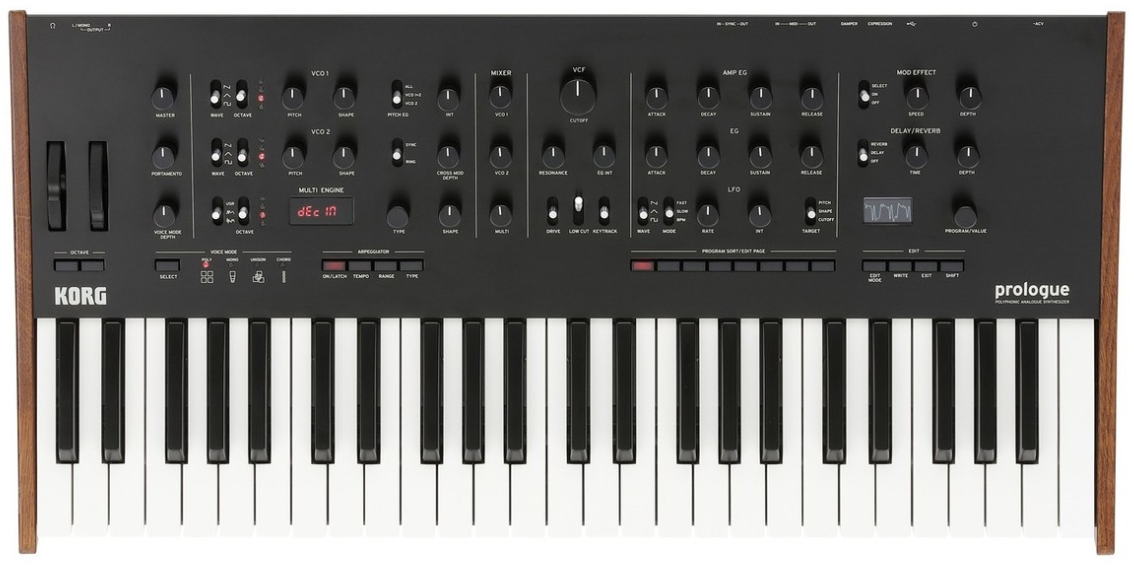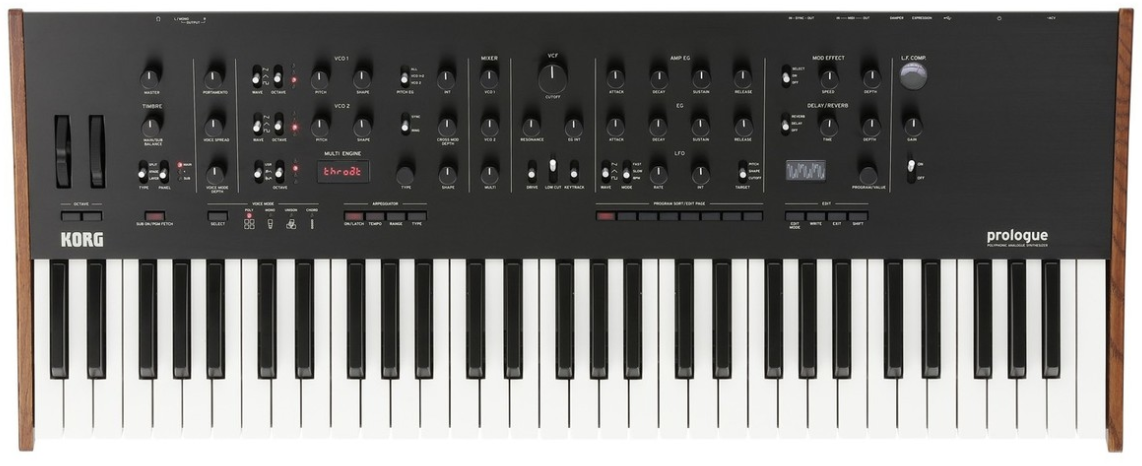
Features:
- Next-gen analog poly synth carrying on the monologue/minilogue line
- 2 analog VCOs + newly developed multi-engine
- 8-voice, 49-key and 16-voice 61-key models
With the Prologue, Korg brings us a high-end polyphonic synth, the latest in their recent series of analog synthesizers which began with the monophonic Monologue and the 4-voice Minilogue.
There are two Prologue models to choose from, the 8-voice 49-key version or 16-voice 61-key model, so it's easy to select one that meets your needs. For our review we used the flagship 16-voice 61-key model.


Oscillator section
First of all, just by looking at the Prologue you immediately get the idea that it's an analog synth thanks to the wooden cheeks, the black solid-aluminum front panel, and let's not forget all those knobs. It simply reeks of high-quality analog, and is very invigorating to look at.
Once powered on, the unit begins a self-tuning process which you're informed of via the small LCD. This is not master tuning, we think, but hardware tuning for each VCO and filter, for each individual voice.
After tuning finishes, the unit boots a patch and is ready to play almost immediately. The Prologue is equipped with three oscillators, two of which are VCOs and the third is a new type called the Multi Engine.
Analog Oscillators
Both the Prologue-8 and Prologue-16 feature the same analog oscillators.
- VCO 1 / VCO 2
Direct from the Monologue & Minilogue, 2VCO x 16 voice for 32 oscillators total (Prologue-16)
- WAVE
SAW、TRIANGLE、PULSE
- SHAPE
By using this knob, you can freely shape each of the three waveforms, for a variety of different tonal possibilities.
- OCTAVE/PITCH
Pretty much self-explanatory.
- PITCH EG
The pitch envelope can be routed to【ALL,VCO1+2,VCO2】 - INT
Controls intensity of the pitch envelope.
- SYNC/RING
Allows syncing of oscillator 2 to oscillator 1 for those sync lead sounds, or ring modulation of oscillator 2 and 1 which is good for producing metallic kinds of sounds. - CROSS MOD DEPTH
Allows control of oscillator 1's pitch via the pitch of oscillator 2.
As far as parameters go, the Prologue has all the basics covered. Even so, one unique feature is the ability to do waveshaping.
Using the Shape knob with PULSE lets you adjust the width of the pulse waveform.
With TRIANGLE, you get similar results, though it's nice to have visual feedback via the oscilloscope so you can see how the waveform is changing.
With SAW, the waveform breaks down, yielding a dirty, sort of distorted sound. It's possible to get a wide variety of different sounds out of just one oscillator.
So, even though there are only three waveform selections, by taking advantage of the Shape function, you have access to a number of variations of those waveforms, which can range from very subtle to downright different.
Multi Engine
The third oscillator, Multi Engine, is a newly developed digital multi-engine. Just from the name it's not so clear as to exactly what this entails, but put simply it's a digital oscillator.
The Prologue lets you mix analog and digital oscillators, thus allowing the creation of sounds not possible with your everyday analog synth. Let's see what the Multi Engine is all about, shall we?
- Noise Generator
There are four types of noise to choose from, via the Type knob. Having this many to choose from means you're sure to be able to make a variety of FX type sounds, we think.
High (high pass filter)
Low (low pass filter)
Peak (peak/band pass filter)
Decim (decimator)
- VPM
VPM stands for Variable Phase Modulation, which is a new development. Basically it's an FM oscillator which offers a selection of 16 types of digital, harmonically-rich waveforms which you just can't get through analog synthesis.
After selecting a type, you can use the SHAPE function and set up some modulation. By using SHIFT + SHAPE you can change the pitch of the modulator, so even if you aren't that familiar with FM synthesis, you can put this oscillator to use along with the analog oscillators and come up with some really rich sounds of your own.
- User Oscillator
This allows the loading of oscillators you design yourself. There are 16 slots, and it comes pre-loaded with one type, the morphing wavetable oscillator.
The User Oscillator lets you load in new oscillators and effects via proprietary librarian software. These oscillators were designed by knowledgeable programmers from around the world, as well as third party developers, by utilizing Korg's open development environment, the prologue SDK.
We're really looking forward to further developments in this area, and we have no idea what kinds of things people are going to come up with.
Filter Envelope Section
Filter
The Prologue has an analog 2-pole low pass filter with controls for CUTOFF, LOW CUT (which works like a high-pass filter cutoff control), RESONANCE, EG INT (envelope modulation), a KEYTRACK switch and a DRIVE knob.
The filter is very sharp, and we got great results programming pad sounds you'd expect from an analog synth, thanks to the subtle nuances you get from adjusting the cutoff. Also, thanks to the peaky sound of the resonance, the character of the self-oscillation and the DRIVE knob, you have access to a broad range of sound, which you can add distortion to, so all in all we think the filter on the Prologue is quite well done.
Envelope, LFO
You get two envelopes, one each for amp and filter. The filter envelope can also be used for the oscillator pitch envelope. This is a really sharp envelope, and the decay speed just really hits the spot. It's very well suited for super quick, punchy percussive sounds.
There is a single LFO, though the LFO rate speed is switchable: when set to Fast, you get audio-oscillator results, reminiscent of ring mod. This is where analog shines! You just can't get these kinds of results with digital.
Effects Section
Effects
Effects on the Prologue include Modulation and Spatial types. Both of which are perfectly suited for use while programming sounds. Also, in the Modulation category there is a slot for User Effects, so again we're looking forward to what people come up with in the future.
- Modulation
CHORUS
ENSEMBLE
PHASER
FLANGER
USER - Spatial
DELAY
REVERB
L.F. COMP.
The Prologue-16 includes a feature not found on the Prologue-8, namely the VU Meter, which is tied in to the newly developed L.F. COMP.—an analog circuit low boost/compressor. This is useful for adding low-end oomph, and boosting the overall level of the sound. The Triton was equipped with a vacuum tube amp, which added a nice color to the sound, and we think the L.F. COMP. takes care of the same duty here with the Prologue-16.
Control Section
Voice Mode
The Prologue has four different modes which can be used for making or playing sounds. Additionally, via the VOICE MODE DEPTH parameter, different effects for each mode can be used to add changes to the sound.
POLY
Standard polyphonic 16- or 8-voice mode (polyphony depends on the model).
VOICE MODE DEPTH enters DUO mode and allows detuning for fatter sounds.
MONO
Sub-oscillator equipped monophonic mode.
VOICE MODE DEPTH controls the octave of the sub oscillator.
UNISON
Monophonic 16-voice unison (8 on the Prologue-8).
VOICE MODE DEPTH controls unison detune.
CHORD
Plays chords with just one key.
VOICE MODE DEPTH changes the chord.
Bi-timbre
The Prologue-16 offers a bi-timbral mode of two 8-voice timbres. Available modes are Split, Xfade, and Layer, which allow the user to experiment with building and balancing the two layers in different ways.
Lots of Other Features
- Arpeggiator with numerous types and range
- MADE IN JAPAN! Natural touch keybed.
- Easy access to the 500 programs via rearrangeable patterns.
- Same sync interface as found on all recent Korg products.
in our Demo & Review video, we sync the arpeggiator to a Volca Beats by using a sync cable.
Demo & Review Video
Well, what do you think?
Written words can only express so much info, mainly about spec and function, but in our video you can hear for yourself the rich analog (and analog+digital) sound of the Prologue-16.
You can also see how easy the synth is to use, so make sure not to miss the video!